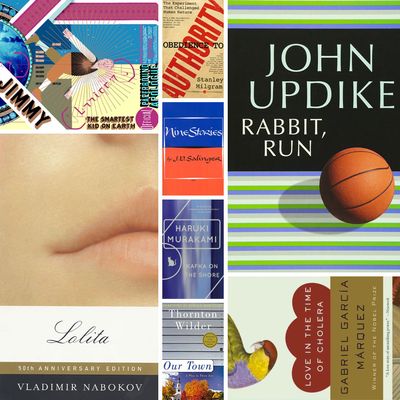
Bookseller┬áOne Grand Books┬áhas asked celebrities to name the ten titles theyÔÇÖd take to a desert island, and theyÔÇÖve shared the results with Vulture. Below is┬ágraphic designer and author┬áChip KiddÔÇÖs list.
Batman:Year One, by Frank Miller and David Mazzucchelli
So many Batman stories and graphic novels to choose from, but I think this ranks No. 1 ÔÇö with MillerÔÇÖs The Dark Knight Returns a close second. To civilians (nonÔÇôcomics fans), I describe this work as a great urban crime drama that just happens to have Batman in it. With a little Dostoyevsky mixed in ÔÇö really.
Lolita, by Vladimir Nabokov
As a brilliantly merciless portrait of mid-20th-century middle America alone, this book is a masterpiece. But we all know it is much more than that. I tend to see it as an intriguingly fiendish parody of Moby-Dick.
Jimmy Corrigan: The Smartest Kid on Earth, by Chris Ware
Full disclosure: I was the acquiring editor of this book for Pantheon, and back in 1999, I pitched it to the Random House sales force as ÔÇ£The Ulysses of comics.ÔÇØ I think that description holds up just fine 18 years and just as many reprintings later.
Obedience to Authority, by Stanley Milgram
This book completely changed the way I think about design problem-solving and how it can work. The descendant of Polish Jews who escaped 1930s Europe just in time, Milgram somehow re-created the workings of Nazi Germany in a small laboratory at Yale University in 1961.
Hazmat, by J.D. McClatchy
Another full disclosure: The author is my husband of 22 years and counting, and this is my favorite of his books that I designed for him (my favorite cover, too). But I must add that it was a finalist for the Pulitzer Prize for Poetry, so itÔÇÖs not like IÔÇÖm entirely biased.
Our Town, a play by Thornton Wilder
I might be cheating by putting a play on this list, but so what ÔÇö itÔÇÖs the best one of the 20th century (okay, let the arguments begin); and it bears endless revisits. The juxtaposition of a thoroughly homespun premise of two families at the turn of the century eventually evolves into a stunning and groundbreaking example of what it means to understand the value of life while youÔÇÖre living it. Have tissues at the ready.
Rabbit, Run, by John Updike
Whenever anyone asks me where IÔÇÖm from, I ask them if theyÔÇÖre familiar with UpdikeÔÇÖs Rabbit books. If they are, then they know exactly what it was like where I grew up. UpdikeÔÇÖs father was my fatherÔÇÖs high-school math teacher in tiny Shillington, Pennsylvania, a suburb of Reading. That the author returned to this completely unremarkable place for inspiration throughout his lifelong career is a source of endless fascination for me. I used to joke that it was like a great painter being inspired by the color beige.
Nine Stories, by J.D. Salinger
I know this is more than a little obvious, but itÔÇÖs also the only book of his that I enjoy rereading. There, I said it. In both ÔÇ£A Perfect Day for BananafishÔÇØ and ÔÇ£For Esm├® With Love and SqualorÔÇØ are two very different and devastating depictions of PTSD, a full seven decades before it was a thing.
Love in the Time of Cholera, by Gabriel García Márquez
Forbidden love so intense and torturous that the characters patiently endure decades of its aching promise just to see if it can ever be consummated. No spoilers here, except to say, ÔÇ£Fuck!!ÔÇØ
Kafka on the Shore, by Haruki Murakami
ItÔÇÖs hard to pick just one of MurakamiÔÇÖs works, but this is my favorite. Impossible to adequately describe here, but itÔÇÖs probably the only novel in which Colonel Sanders (yes, that one) will scare the hell out of you, and then later make you cry tears of joy.

